Axolotl in aquaristics
Table of contents
- We are here for you
- Where does the axolotl come from?
- Axolotl and the IUCN
- Husbandry of Axlotl
- Physique and sex
- Miraculous regeneration in the axolotl
- Keeping axolotls
- Diseases of the Axolotl
- Technique for the Axolotl Aquarium
- Breeding of Axolotl
- Nutrition of Axolotl
- Diseases of the Axolotl
- Salt bath treatment for axolotls
- Colour forms of axolotls
- Finally
We are here for you
With their droll appearance, axolotls have been crawling their way into the hearts of aquarium hobbyists for quite some time, yet at the same time they are something quite different from the usual fish or terrarium animals. These tailed amphibians belong to the salamanders and are capable of reproduction even in their eternal larval stage. The popular little aquatic monsters already come in many different colours and are quite uncomplicated to keep and breed in a species tank if you know a little more about them.
As passionate aquarists, we will gladly take you by the hand if you are interested in axolotls and would like to keep and even breed these great amphibians yourself. Even if you get stuck, you can always look things up and jump directly to the topic you are interested in via the table of contents.
In this article, we show you what you can and should pay attention to so that you can enjoy your fellow inhabitants for as long as possible.

Where does the axolotl come from?
The original habitat of axolotls are ponds and ditches in the Mexican plateau, where they once occurred near Lake Xochmilco and Lake Chalco. Due to the high population density in Mexico, as well as the associated damaging environmental factors, the axolotl has become almost extinct there and over time has achieved a very special evolutionary development: it can already reproduce in the larval stage! This event is also called "neoteny" and refers to a partial metamorphosis, i.e. a half-evolution.
Mexico City today is the former Tenochtitlan, which was built on an island in the lake of the same name, which in turn was home to the axolotl. As the lake was drained and built on, the habitat became smaller and smaller, so that today only very small areas of the original lakes exist. Since Mexico City, with over 20 million inhabitants, is one of the world's largest cities, it can be assumed that the species of axolotl is now almost extinct in its natural environment.
In 1798, the axolotl was first described by SHAW as Ambystoma mexicanum, but it took more than fifty years before the little oddball gained real research interest. Its name axolotl comes from the Indian and Aztec languages and means "water monster" or also "water slave", which does justice to its appearance. Among other things, the deity Xolotl was honoured, which in turn was derived to "ajolete" in Spanish. Ultimately, myths and religions played a major role.
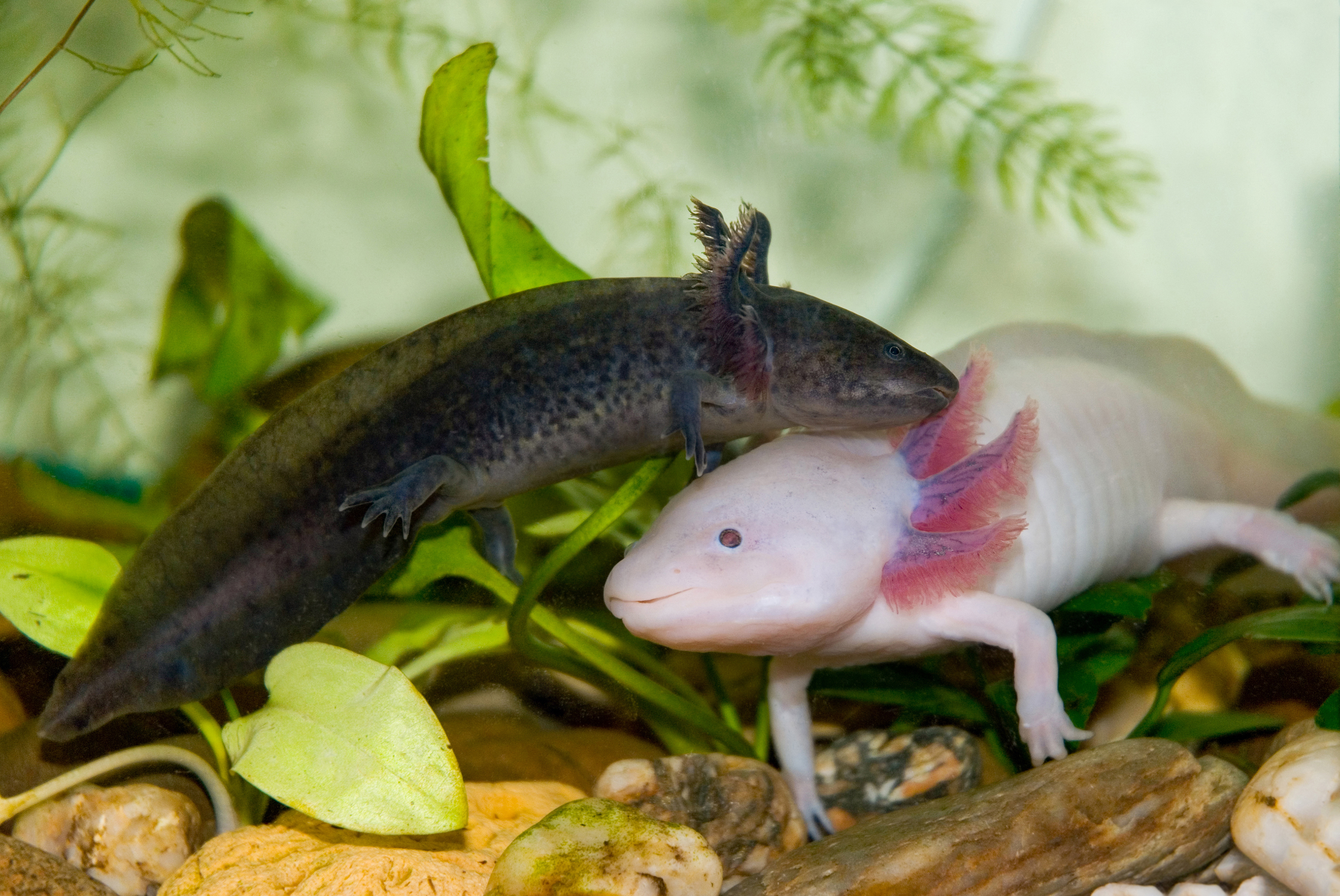
In 1863, General Fory's expeditionary corps brought a few specimens back to Paris and caused amazement and astonishment among experts, because the fact that an apparently juvenile-looking newt could reproduce was completely unknown until then. In its native country, the axolotl was a popular delicacy and was even offered on the market until the '30s.
It was not until the end of the 19th century that the axolotl also aroused European interest, although it was certainly confused with another Ambystoma, which is why old traditions are often still somewhat mixed up. A total of 33 living animals were brought back on the expedition, among them an albino, which finally aroused the interest of researchers who wanted to get to the bottom of the mystery of the juvenile stage. To this day, it can be said that the hype surrounding the axolotl continues and poses new riddles to scientists all over the world, which is why it is also a sought-after laboratory animal today.
Just 7 axolotls represent the forefathers of the animals found in zoos or private aquariums today. Interestingly, the white line was also preserved and it turned out that the usual inbreeding factor seems to play a less important role in axolotls than in other species. This is possible, among other things, because lotuses have less "adult" tissue and their juvenile organs, which enable interesting regeneration, virtually eliminate potential genetic defects. Before the import ban came into force, however, many axolotls were taken from their habitat, which is why the bloodlines are probably more widely dispersed than originally assumed.

Axolotls and the IUCN
The IUCN is the International Union for Conservation of Nature, which defined the axolotl as "CriticallyEndangered" in 2006. So it remains to be seen when the cute water monster will be considered "extinct". The IUCN refers to its occurrence in the habitat. Aquaristics is therefore an important part of species conservation, because this is where most amphibians are kept and also reproduced. And even though the axolotl sometimes offers great colours, it is to be hoped that some prudent amphibian lovers will also preserve the wild form.
Therefore, in this blog you will learn how you can not only keep your favourites, but also propagate them, in order to make an important contribution to species conservation.
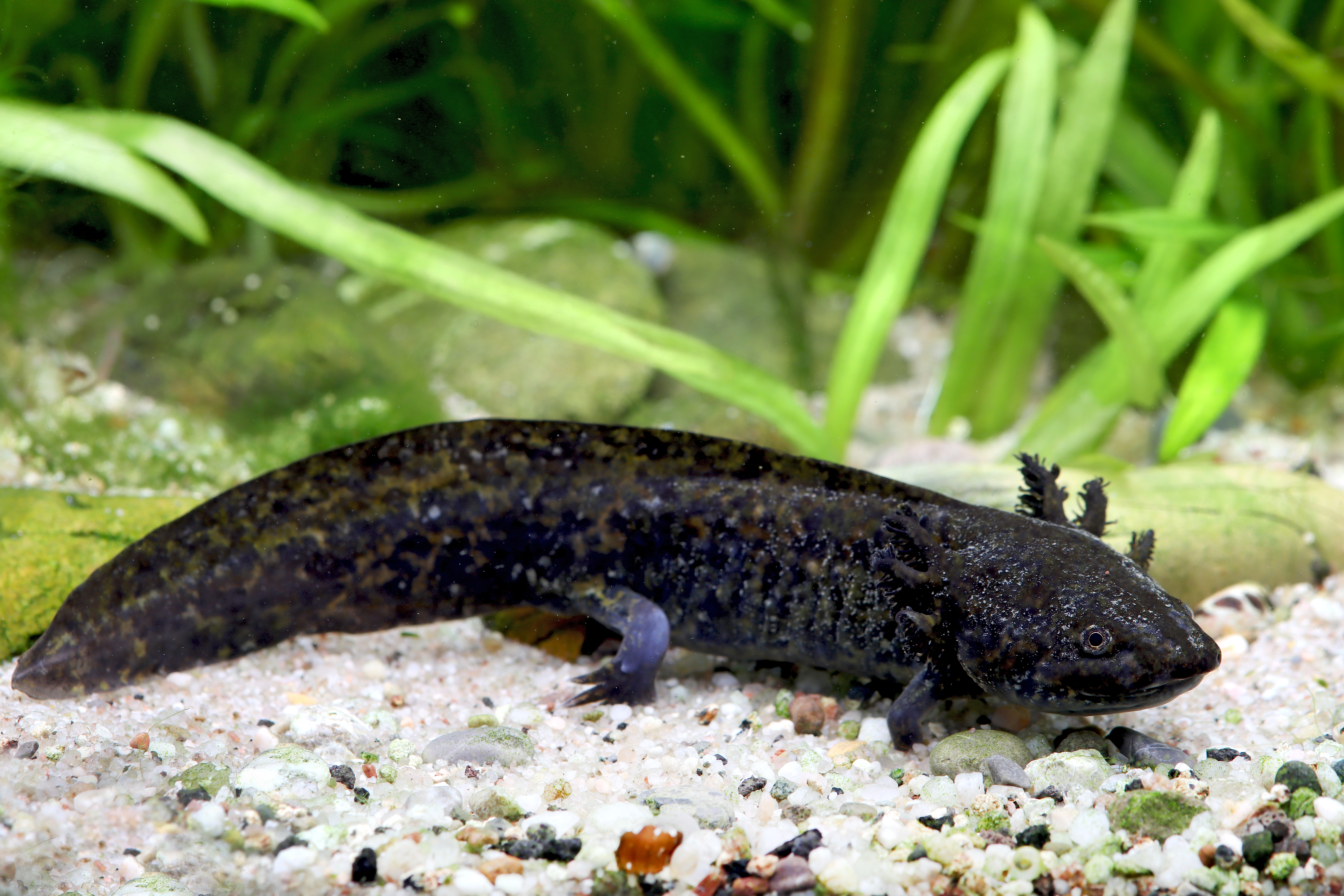
Physique and sex
An adult axolotl grows to an average length of about 23 to 28 cm, but there are also - rather rarely - much larger specimens that can grow to between 30 and 40 cm. The lotus has funny dark, rather small eyes and cute-looking little arms. It moves forward in the water with its rowing tail. Its flat head has a very wide mouth that looks as if the animal is smiling all the time. This gives the caudate an extremely friendly appearance. A swimming fringe runs from just behind the head along the back over the tail to just before the cloaca under the belly.
To see if your lotus is a male or a female, you have to look at its buttocks: The male's cloaca bulges out a little, while the female's cloaca is flat.
By the way, axolotls do not become sexually mature until they are between 1 and 2 years old.
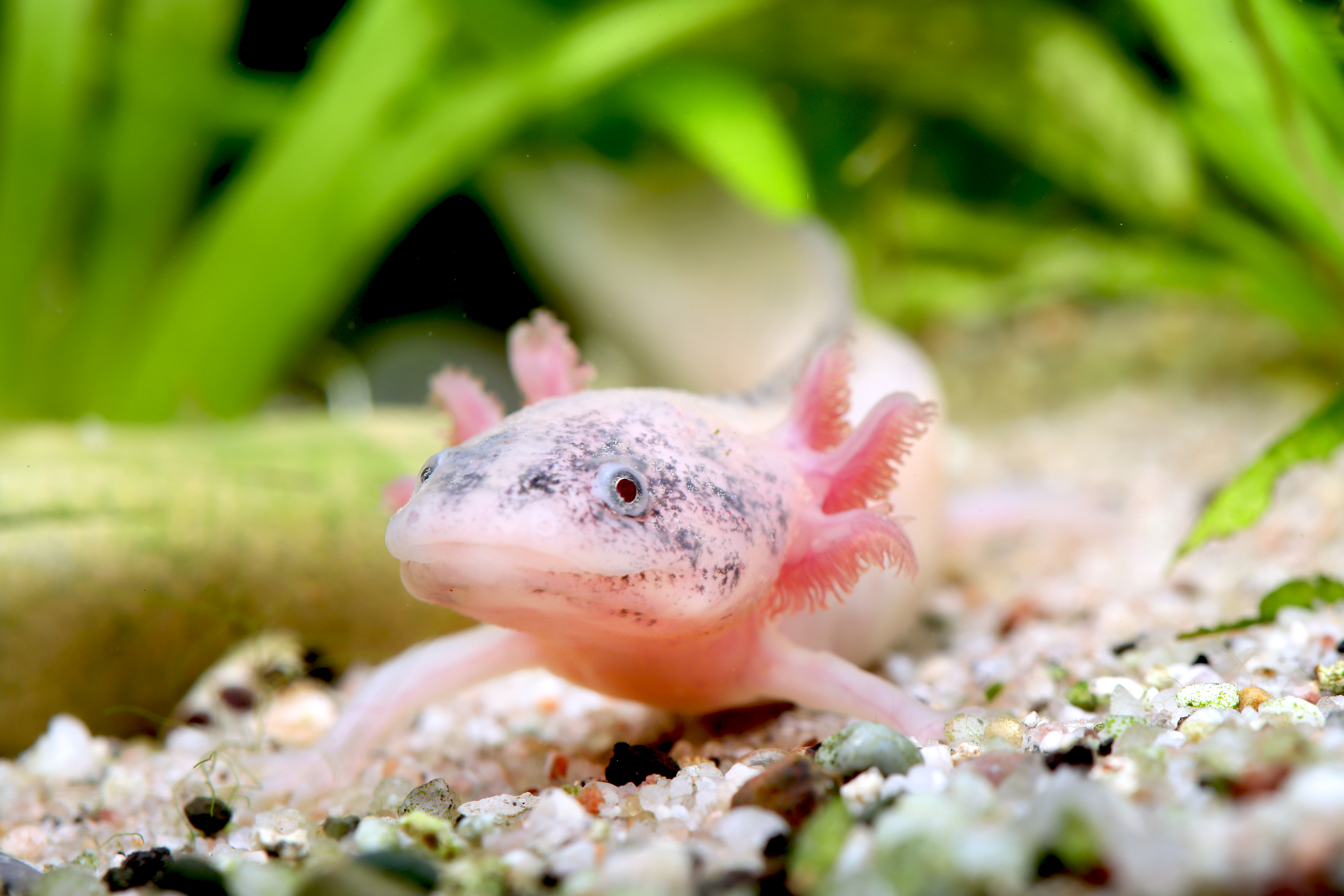
Miraculous regeneration in the axolotl
The axolotl has an almost legendary ability to regenerate. If it loses limbs or even gill parts, it can simply grow them back over time. Even the loss of a leg is therefore not a serious incident!
Keeping axolotls
Axolotls can be kept very well individually or in pairs in the Artaquarium. Per lotus you should calculate 50 to 80 litres of aquarium volume as a rule of thumb, whereby the base area is much more important than the aquarium height!
- Single keeping: aquarium with 80 cm edge length and approx. 100 litres volume
- Keepingpairs or small groups of up to 3 animals: aquarium with 100 cm edge length and approx. 160 to 200 litres volume
If there are even more animals, the aquarium must of course be even larger and equipped with many retreats and hiding places.
Axolotls need medium-hard to hard water with a total hardness of over 6 °dGH and a pH value of 7 to 7.5, maximum 8. Water that is too soft leads to stress and can cause the amphibians to lose their colour. If your tap water is too soft, you can harden it up with a special hardening salt to enrich it with minerals.
Heavy metals such as copper should not be present. The nitrite value should not exceed 0.3 milligrams per litre in the aquarium, a nitrate content of up to 25 mg/l is still okay, but it should never exceed 40 mg/l. Axolotls may react very sensitively to chemical water additives, so you should avoid these at all costs.
Axolotls react very positively to humic substances such as alder suppositories or almond leaves . They can even be used to prevent disease.
An aquarium for axolotls should always be equipped with natural sand or fine-grained, rounded natural gravel with a maximum grain size of 3 mm. Axolotls always unconsciously pick up a few pebbles and grains of sand when foraging. Pebbles that are too large can lead to a fatal intestinal obstruction, sharp-edged pebbles can injure the animals, and the amphibians can simply poison themselves on coloured plastic gravel.
With stones and especially with caves of a suitable size, you can create good hiding places and structures for the axolotls in the aquarium, but they also need open spaces to run around.
The Plants for an axolotl aquarium should definitely be able to cope with cool water. Robust species such as hornwort, nixwort, Java fern, Anubias or various mosses, Vallisneria and co. are a good choice for an aquarium with amphibians. Floating plants provide the necessary shade, which suits the rather light-shy amphibians.
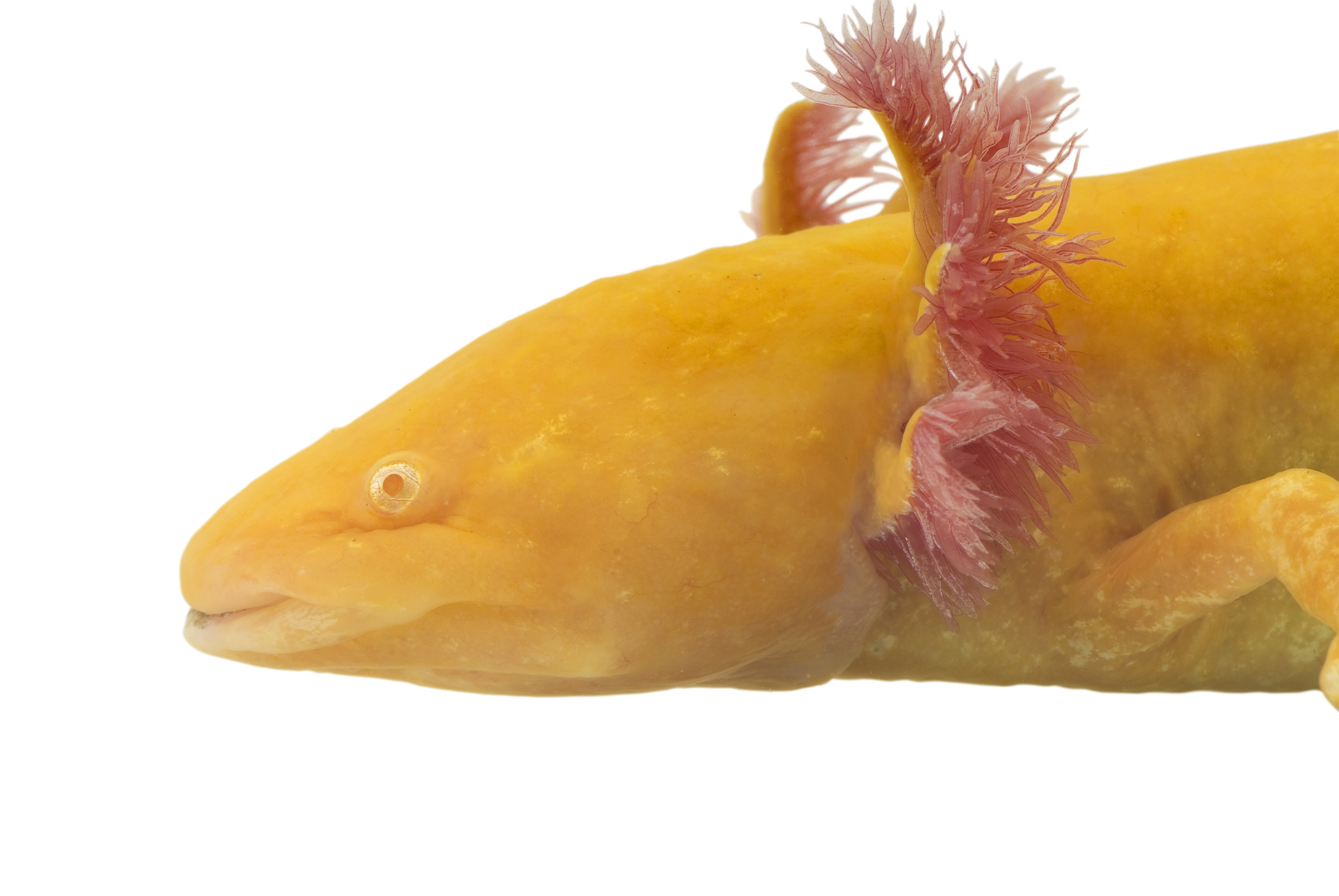
The technology for the Axolotl aquarium
The water temperature in the aquarium isimportant for axolotls: the animals are cold-water animals and need a temperature range of 12 to a maximum of 20 °C. Higher temperatures quickly lead to severe damage. Higher temperatures quickly lead to severe stress and subsequently to serious diseases. Especially in summer, the water temperature is therefore a challenge - the axolotl aquarium does not need heating, but it does need effective cooling! The usual fan-based aquarium coolers are often not powerful enough - cooling units for aquariums, which are originally used in marine aquariums, have proved to be ideal. Of course, this is also a maximum solution in terms of price.
If it gets too warm in your home and you cannot cool your aquarium sufficiently, you can keep your axolotl in a cool cellar over the summer, for example.
The aquarium for the Mexican tailed amphibians always needs an efficiently working filter - axolotls depend on very clean and oxygen-rich water. However, the current should not be too strong so that the amphibians are not stressed. Good experiences have been made with sufficiently dimensioned external filtersThe filter outlet is set in such a way that there is very good water movement at the water surface and thus an effective gas exchange.
In general, axolotls are quite special in their demands on water quality, aquarium temperature and aquarium equipment and should therefore preferably be kept in a species aqu arium. Smaller fish become live food, as do snails or shrimps. Crayfish can pinch and injure the amphibians, so they are not a good choice either. Larger fish also pose a risk of injury to the sensitive gills and can also stress the Lotl quite a bit. Very dangerous for all amphibians is the chytrid fungus Batrachochytrium dendrobatidis, BD for short, which triggers chytrid myosis, which is also fatal for axolotls and has been causing worldwide amphibian mortality for several decades. Crayfish and other aquatic animals can transmit the dangerous fungus. For all these reasons, we expressly do not recommend axolotls for community aquariums!
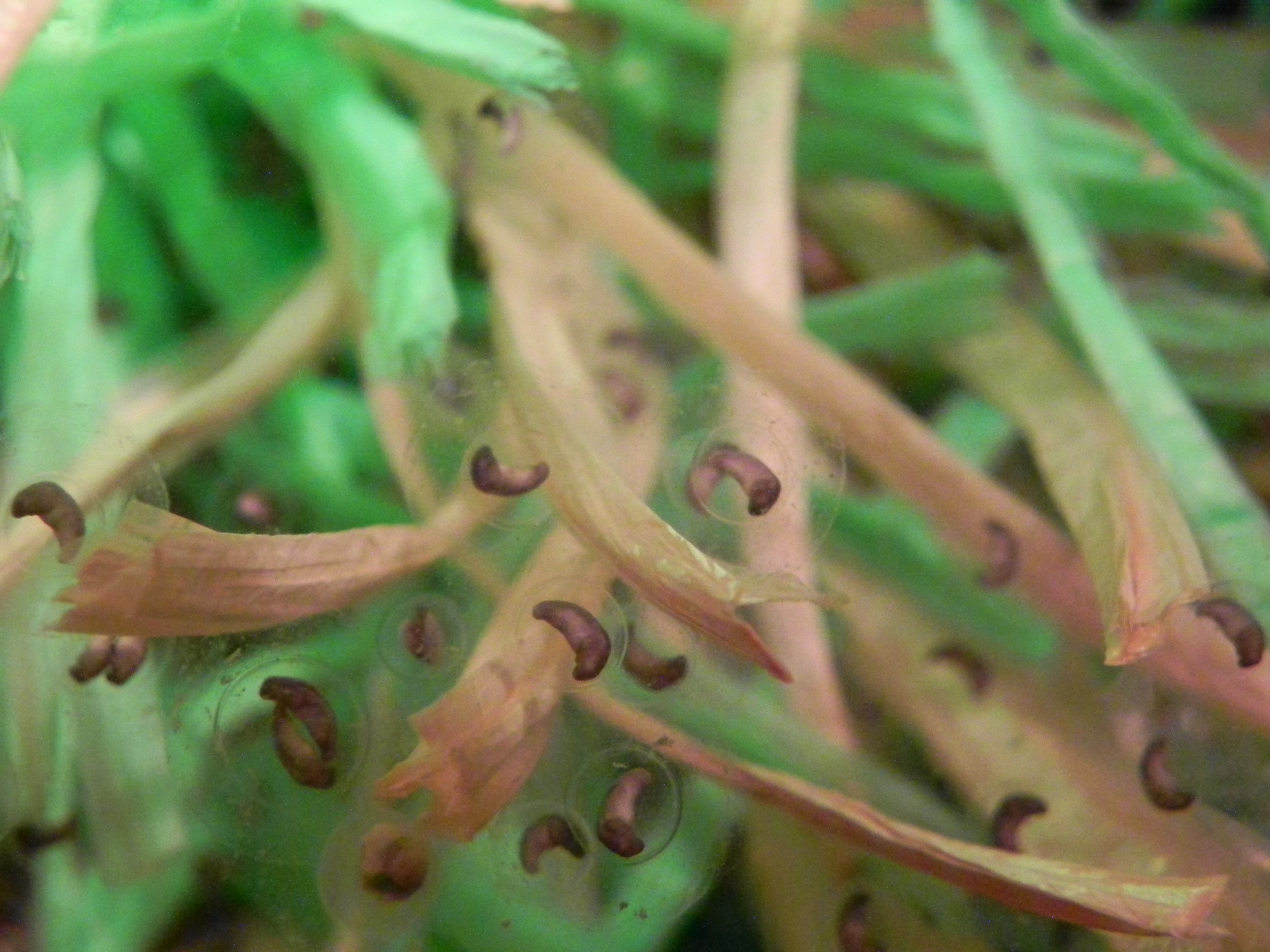
Breeding axolotls
In principle, axolotls are quite easy to breed, but you should pay attention to a few things to make sure it works. First of all, you should make sure that you definitely have a male and a female that are at least 18 months old. The breeding pair should also be well sewn. Males that are ready to breed can be recognised by their swollen cloacal gland, which indicates increased spermatophore production. It is advantageous to keep the breeding pair alone so that they are not distracted by other animals.
You can get them in the mood by lowering the temperature to 12-14°C for a few weeks and then bringing it back up to a comfortable temperature. You will probably not notice the actual mating, as it often takes place at night. The male releases a spermatophore, which the female takes up in her cloaca. About 12-15 hours later, the female lays her eggs, which may take a few hours.
Depending on the age and size of the female, the number of eggs can range from 100 to 150. Immediately after laying the eggs, they swell up and can reach up to five times their original size. They are laid between and on stones, but also on plants and aquarium equipment. After laying the eggs, you should remove the breeding pair from the tank.
To prevent the eggs from becoming fungal, you can use a weakly dosed disinfectant or a humic acid-based preparation such as our Humin Liquid into the water. If some of the eggs become fungal or die, you should remove them so as not to endanger the rest of the clutch. You can also use an aerator to ensure gas exchange. Change some of the water regularly, but make sure that the water is at least the same temperature or higher. In general, you can keep the rearing aquarium a little warmer, then the larvae will develop a little faster, but the water quality will suffer.
After about 14 days the first larvae hatch, then you should also remove the remaining egg cases from the tank. The small mouth of the animals is already recognisable as a line but still closed, also the front legs are rudimentarily formed. Only after about 24-36 hours do the larvae finish their emryonic development and feed on their yolk sacs. Interestingly, it is only after this time that their mouths open and are functional for feeding.
The front legs develop before the hind legs and in the 3 weeks after hatching, their little fingers gradually develop. Only at an advanced age of about 10-12 weeks can the hind legs be seen. From a size of about 4 cm the small larvae can be fed with larger food such as Tubifex or mosquito larvae. Make sure that your animals have enough space so that they can develop freely, if necessary you can also relocate some of them to another breeding tank.
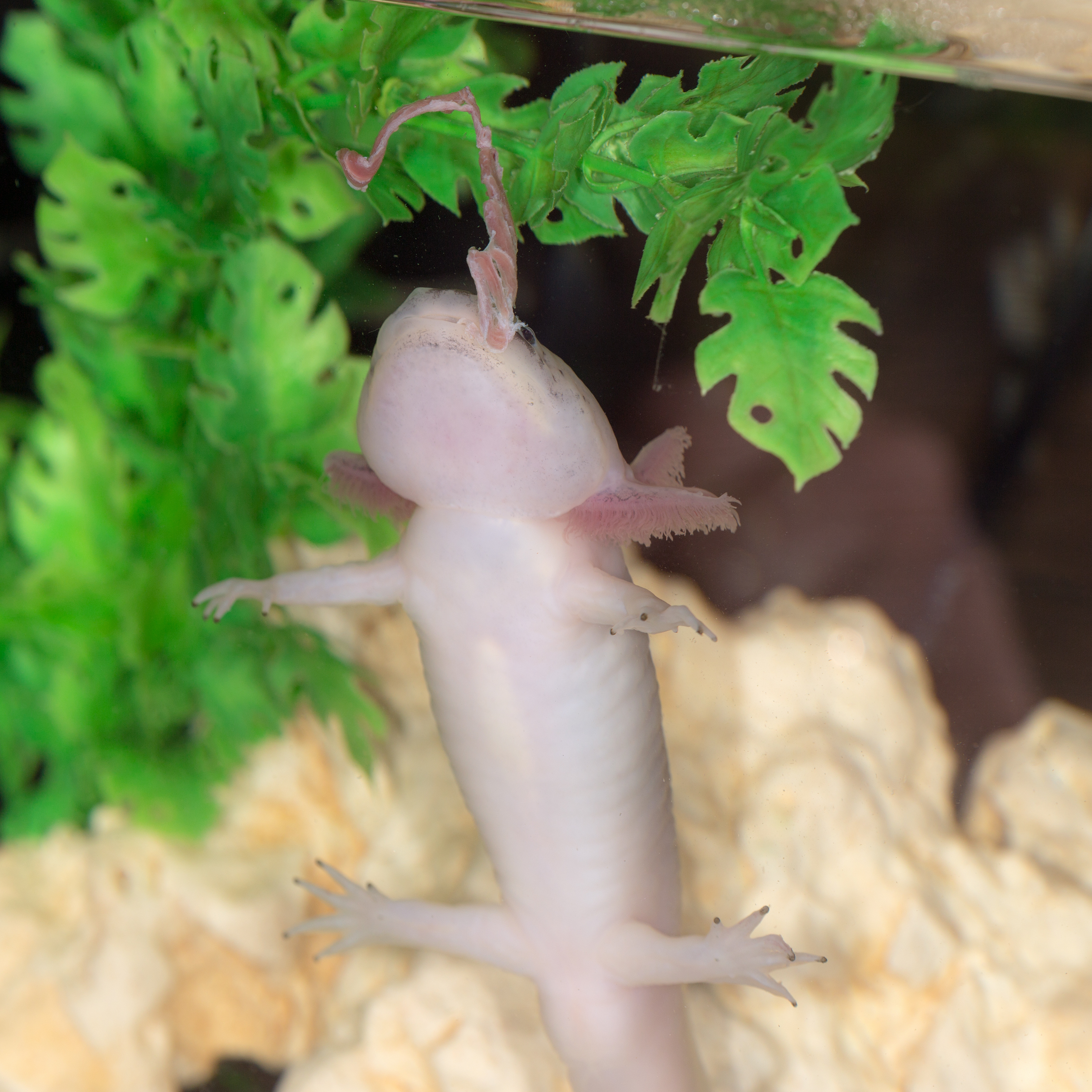
Axolotl diet
As lurking hunters, axolotls wait quietly and patiently for their food: they eat invertebrates such as small crustaceans, insect larvae, mussels, smelts and worms, but also small fish. In addition, the caudate amphibians also help themselves to the spawn of other amphibians and even to their own offspring. Unlike other land-dwelling amphibians, axolotls will also eat dead meat, so you can even get them used to scraped beef heart, but make sure that there is no fat or connective tissue attached to the muscle meat and that there is no blood on it. Your axolotl cannot digest this.
In the aquarium, axolotls like to eat live mosquito larvaeworms and insects, but they also like crustaceans such as Gammarus. Earthworms, fly maggots or tubifex are also suitable, you can also use food fish such as guppies, which are usually caught at night. Feeding live fish is also advantageous because they do not affect the water quality, and you can also use them as "weekend food" when you are away from home.
Axolotl pellets are also occasionally possible. However, these are foods for commercial fish farming of saltwater fish and should therefore be used only rarely. Because this food contains colourants, it can be used to improve the colour of gold albinos, the so-called "Humphrey hybrids".
Younger specimens should be fed daily, adult axolotls only need food twice a week. When you feed your axolotl, you should dim the light in the aquarium. This is very beneficial for these rather nocturnal creatures.
To prevent your animals from falling ill, you should feed them a varied diet, especially fresh food, but do not change the food more than twice a week.
Very young axolotls should be offered freshly hatched nauplii, which you should rinse thoroughly beforehand so that no salt residues adhere to them. Also, do not put too many nauplii shells into the tank, as these can lead to deadly blockages in young axolotls. You can also feed plankton, but always make sure that the food is free of parasites.
Frozen food is also suitable for your lotus, but you should bear in mind that various parasites could be frozen in, for example in the case of red mosquito larvae a protozoa from the ciliates family, which could thaw in the tank and infect your amphibians.

Diseases in axolotls
Although axolotls are considered to be very robust animals if the conditions in the aquarium are suitable, they can become ill with bacterial or fungal infe ctions or become susceptible to parasites if they are stressed by excessively high aquarium temperatures, a lack of oxygen, too strong a current or unsuitable water values. Toxins, for example from softeners in air or water hoses, can also be very harmful to them. In general, axolotls are susceptible to many diseases that are also known from other animals or even from humans, such as Chlamydia psitacci, but also infections with Hexamita, Opalina, Trichodina or Costia. Even jaundice, i.e. hepatitis, can be transmitted to them and usually ends fatally as a viral infection.
An infestation with the dangerous chytrid fungus Batrachochytrium dendrobatidis or BD can be recognised by brown discolouration on the mouth, feet, cloaca, abdomen or tail area and by strong hornification on the flanks. If diagnosed early, a bath with Lamisil can help - but only after consulting a vet. Basically, however, you should do everything possible to avoid infection with this very dangerous pathogen! The aquarium must be thoroughly disinfected before the infected animal is allowed back into the aquarium after treatment.
Axolotls can also suffer from parasite infestations - gill crabs can lead to serious inflammations. Ciliates can also colonise weakened animals and make them ill. Infected axolotls become sluggish and no longer eat well. Flagellates that spread in the large intestine can also cause skin problems. Also causing skin problems is an infestation with the protozoan Ichtyosporea, which causes blisters and subsequently severe sores and growths. There is no treatment against this parasite.
Furthermore, axolotls can also suffer from fungal diseases or bacterial infections if they are stressed and poorly kept. The best treatment for these diseases is a salt bath.
By the way, you can find vets who specialise in amphibians or axolotls at axolotl-online.de.
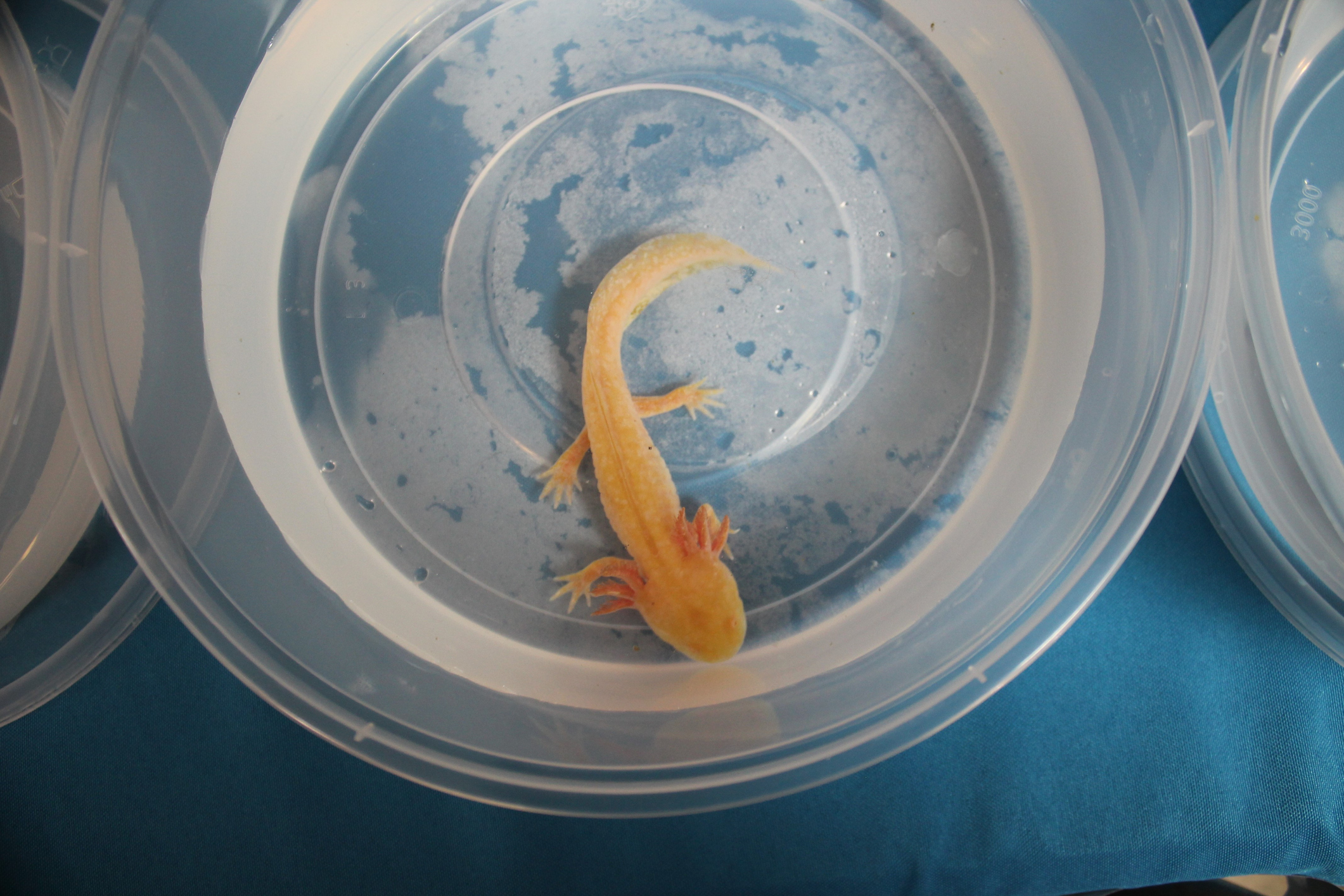
Salt bath treatment for axolotls
Salt baths for axolotls with fungal or bacterial infections have proved to be an effective first aid measure. For a short-term bath, add 1 heaped teaspoon of dishwasher salt to 1 litre of water and place the affected axolotl in the bath for 20 minutes. Repeat this daily until the symptoms improve.
For a permanent salt bath, add 1 heaped teaspoon of dishwasher salt to 10 litres of water and place the lotus in this solution. Renew daily. After 5-7 days the symptoms should have improved.
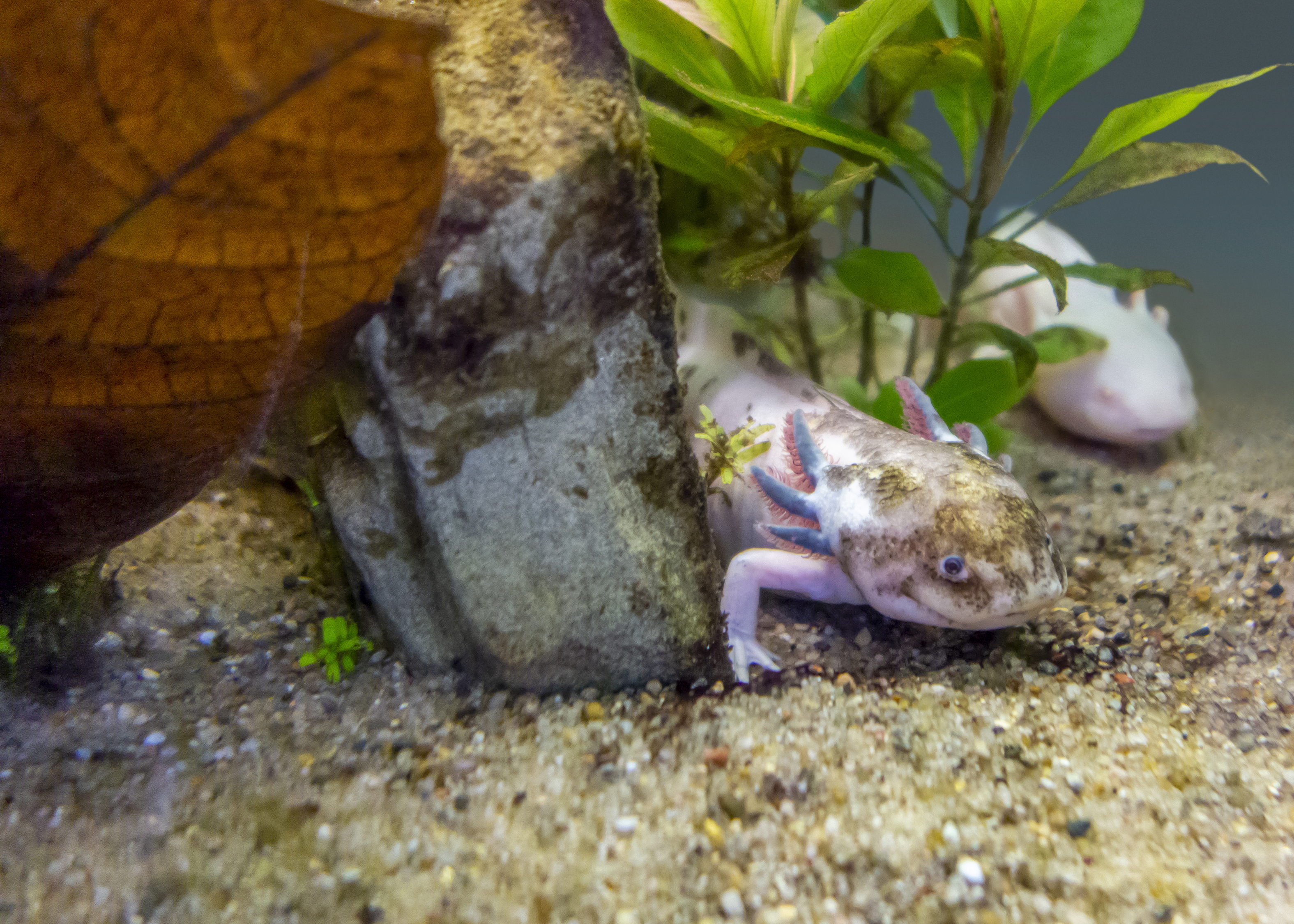
Colour forms of axolotls
Axolotls are easy to breed, and you can buy them in many different colours and shapes for the aquarium. You can mix the different colours very well, because the lotuses don't care what their mates look like.
Axolotls have three different colour cells that are responsible for their colouration:
- Melanophores produce dark pigments
- Xanthophores produce yellow pigments
- Iridophores produce shiny pigments
The following colourings are possible in Amblystoma mexicanum:
- Wild form: the basic colour of wildlings is light grey to black with lighter spots, the gills are usually dark. Many wildlings have shiny spots in the tail area. They have all three colour cell types.
- Melanoid: These axolotls are dark brown to black. The gills are also dark coloured. They do not have shiny iridophores.
- Axanthic: A lotl without xanthophores, i.e. only with dark pigments, black or dark brown, but with iridophores, i.e. shiny spots.
- Pigmentless albino: This colour form is completely white except for the red gills and has red eyes. It has no colour cells at all.
- Axanthic albino: Although it has no yellow and dark pigments, it has iridophores and thus a slightly metallic shimmer, in addition red eyes and red gill branches.
- Golden albino or Humphrey's axolotl: These literally golden axolotls lack the dark pigments, but yellow colours are present, as are the shiny pigments of the iridophores. The gills are red. The scientist Humphrey was the first to achieve this colour pattern by crossbreeding tiger salamanders.
- Melano-Albino: Here not only the dark pigments from the melanophores are missing, but also the metallic shimmer of the iridophores is absent. The xanthophores that are still present are responsible for the slight yellow tinge. Eyes and gill branches are red.
- Whites: Unlike the pure albinos, the whites with their red gills have few other colour pigments due to iridophores, melanophores and xanthophores - only the distribution is very uneven and often limited to the back and head. Whites have black eyes and are the most common colour form in aquaristics.
- Harlequin: A variety of the whiting in which the colour pigments appear mainly in the head area and look like a mask.
- Copperor biscuit: The copper-coloured axolotl is a rather rare colour form, which shows lighter and darker spots on a creamy copper base colour. The gills are also red here.
Finally
There is certainly a lot more that can be reported about axolotls, so we will be adding more exciting data as time goes on, stay tuned!
